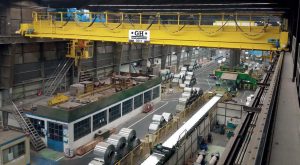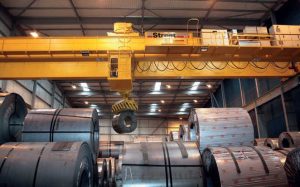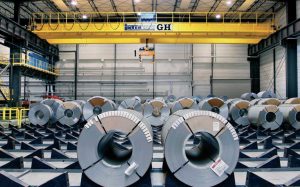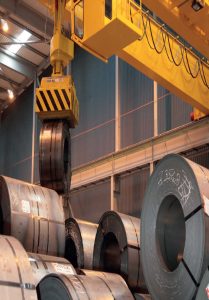Application and Upgrade of Various Overhead Cranes in the Metal Processing Industry
In the metals handling sector the three key words that crop up again and again are safety, monitoring and automation. Simon Hastelow reports.
For lifting in the metals handling and distribution sector, the industry appears to be split into two distinct camps: above-thehook and below-the-hook. While it is obvious that tools attached below the hook to grip and lift metal coils, sheet and bars are very specific to the task it would be a mistake to assume that the equipment ‘above the hook’ is generic to any form of lifting. Often the design and structure is just as specialised.
- A double girder overhead crane for Umicore Building Products France. It has an open winch crab (1)
- A double girder overhead crane for Umicore Building Products France. It has an open winch crab (3)
- A project carried out by GH Poland for Gonvarri Polska three double girder overhead cranes
- The 12,880sqm Innovate Round Oak steel facility can hold up to 60,000t of steel. With Electromagnetic crane
“We specialise in the cranes, including the hoist,” says Juan Aguirre, sales director, special solutions for GH Cranes. “The equipment below the hook is provided by other companies. It is a completely different industry catering to wide industry requirements. There are magnets, coil grips, C-hooks and there are hooks which allow rotation, others with integrated scales to weigh the stock. The variables are infinite with different brands and qualities.
“Normally a customer will come to us after deciding the below-hook equipment supplier. Or sometimes we will supply a replacement overhead crane where the below-hook equipment already exists. But if it is a new installation and the customer asks for advice we would often choose a supplier with a service facility located near to the plant.”
For lifting rolled metal coils there are several distinct types: C-Hooks, a very simple and effective solution usually cut from single alloy steel plate and designed for heavy continuous use as they require little maintenance, used when stacking coils end-to-end and access to the coil centre is restricted to one side; telescoping coil grabs, the preferred solution when handling coils where the axis is horizontal, open both sides and the customer needs to handle a wide range of coil diameters; parallelogram coil lifters, commonly used where the coil axis is horizontal but where the aisles are narrow in the coil storage areas; and vertical axis coil tongs, for coils positioned with the axis vertical and the underside of the coil is not accessible, can handle a wide range of coil sizes either single-rim grip or double-rim grip.
Aguirre adds: “The coil grips vary depending on design and storage requirements. You can handle coils with an electromagnet to maximise space, but the cost is increased compared to standard coil grips or hooks. This is an equation that the end user needs to solve, with our help, marrying the variables between increased overhead crane cost and more optimised storage space.”
Oliver Kempkes, managing director of Kuli Hebezeuge says: “We mainly sell either just components or complete overhead cranes. In the export market we have a lot of installations in the Middle East for metals handling and aluminium production. These customers mostly use our hoists, travel drives and controls then build their own cranes using local contractors. Whereas in Germany we mostly sell complete cranes which are completely designed and built by us.”
Application and Upgrade of Various Overhead Cranes in the Metal Processing Industry




没有评论:
发表评论